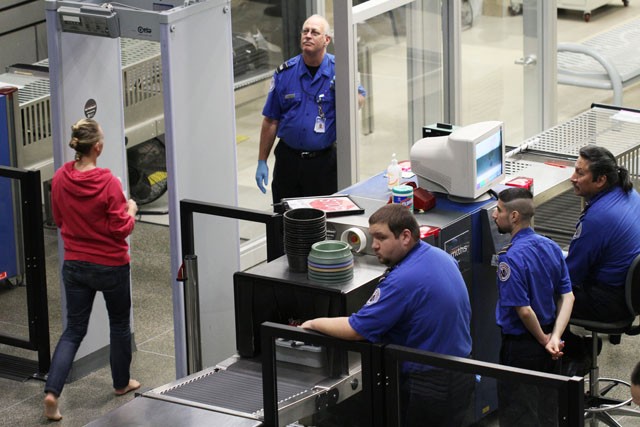Whether traveling by plane, bus or car, students returning home for the Thanksgiving holiday may face a few speed bumps on the way.
Those traveling through the Minneapolis-St. Paul International airport will face Advanced Imaging Technology screenings âÄî an additional security measure first added in September.
The screenings, an alternative to traditional metal detectors, produces a detailed image that can expose metallic and nonmetallic objects, including weapons and explosives. The process is optional for all passengers. As a substitute for the screening, passengers can choose to have an enhanced pat-down instead.
But some passengers are calling the scans invasive and on Wednesday, a National Opt-Out Day, will take place at airports across the country. Protestors will submit to a pat-down in hopes that it will slow the lines right before the Thanksgiving holiday, angering travelers and drawing government attention.
University of Minnesota students have mixed views about this new technology.
Lizz Feldt, a second-year graphic design student, will be traveling home to Milwaukee for Thanksgiving. She opted to travel by plane because of the cheap tickets she found. She said sheâÄôs not happy about the scan sheâÄôll have to go through.
âÄúI think it is a little ridiculous honestly,âÄù she said. âÄúItâÄôs infringing on privacy rights and it could be used for inappropriate things.âÄù
However, the Transportation Security Administration assures measures are being taken to protect the privacy of passengers.
Privacy protections include: screening rooms that are hidden from the public, the deletion of images immediately after viewing and blurred parts of all images.
Pat-downs, meanwhile, âÄúare conducted by same-gender officers, and all passengers have the right to request private screening at any time in the screening process,âÄù TSA officials said in a statement. âÄúTSA takes passenger privacy very seriously and builds privacy protections into its security procedures.âÄù
Fourth-year student Kristin Martin said she would rather comply with the new technology.
âÄúI would much rather get a scan then get patted down,âÄù she said. âÄúThe people conducting the scans are professionals. It is just like going to a doctorâÄôs office.âÄù
Feldt remains unsatisfied with the new technology despite privacy precautions.
âÄúIf it catches a person, thatâÄôs great,âÄù Feldt said. âÄúBut it is putting the rest of us on the spot when most of us are not terrorists.âÄù
Busses a popular alternative
Students opting out of body scans and enhanced pat-downs can take advantage of bus transit and ride share opportunities.
With 13 routes originating from college campuses in Minnesota, North Dakota and Wisconsin, Jefferson Lines College Connection is popular among students.
The numbers of total bus tickets for Jefferson Lines this weekend are double and triple the amount for their regularly scheduled routes, Jefferson Lines Vice President Bonnie Buchanan said. As of 3 p.m. Monday, 132 tickets were sold for the Minneapolis-Madison route alone.
âÄúWe are just busting out of the seams with passengers at this point,âÄù Buchanan said.
At the information desk in Coffman Union, 29 Jefferson Lines student bus tickets were sold during November. Jefferson Lines tickets are predominantly sold online, said Beth Galatis, Coffman information desk manager.
The holiday season, beginning with Thanksgiving, is typically busy for the company, Buchanan said. But this year bus travel is much bigger than in the past. She said the change could be attributed to the economy, the expansion of routes and schedules and increased services on buses including Wi-Fi.
âÄúWe have heard from a number of students that are new to the bus because their parents decided they just couldnâÄôt afford to have a car parked on campus,âÄù she said.
One of the greatest advantages for students is that the bus picks up on campus, she said. Both Megabus and Greyhound Lines do not have stops on campus, but are located within walking distance of MetroTransit bus stops downtown or near the airport.
Students opting out of bus travel can also carpool home using sites like Zimride or other rideshare opportunities advertised in their residence hall.
Zimride allows students to post an online ride request on a University page for the city they are heading toward. With 26 rides, the Minneapolis-Milwaukee route was the most popular, as of 3 p.m. Monday.
A blizzard Wednesday evening might disrupt travel plans for students who have classes and exams.
Tara Castellano, a first-year student from Farmington, will probably take the Metro Transit bus home after her Psychology 1001 exam, and said the weather wouldnâÄôt interrupt her travel.
But for Tori Thompson, who will drive from the cities to Duluth Wednesday night after classes and work, the road might be more dangerous. But she said sheâÄôs not worried.
âÄúItâÄôs November, itâÄôs going to snow,âÄù Thompson said.

Image by Erin Westover
TSA employees wave people through the security scanner Friday evening at the Minneapolis- St.Paul International Airport. The scanner is part of a new process using Advanced Imaging Technology to screen for both metallic and non-metallic objects.
Holiday travelers to face obstacles
New airport screenings and bad weather could complicate Thanksgiving travel.
by Cali Owings
Published November 23, 2010
0
More to Discover







